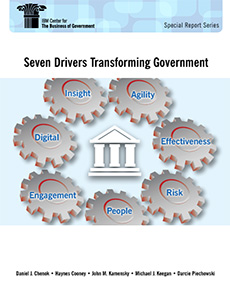
Drivers Transforming Government: Effectiveness

Note: The IBM Center recently released Seven Drivers Transforming Government, a series of essays exploring key drivers of change in government. It is based on our research and numerous insights shared by current and former government officials. This blog is the third in a series of excerpts from each of the seven essays. (See the previous post on agility.)
Making government more effective has had support across multiple administrations. Numerous bipartisan initiatives to improve government operations have been implemented, including the adoption of enterprise approaches to deliver mission-support services across program and organizational boundaries and initiatives to expand the use of data and evidence to make more rational resource allocation decisions.
As Professor Jane Fountain acknowledges in her special report for the IBM Center and the Partnership for Public Service, Building an Enterprise Government, the future of government performance relies not simply on greater efficiency, but also on increasing capacity to leverage an enterprise approach across agencies.
Driving meaningful and sustainable effectiveness in the federal government depends not just on new policies or the adoption of innovative technologies, but a focus on sound implementation. Shared services initiatives in mission support functions such as financial management and human resources have been instituted; looking ahead, framing budget and strategy plans from an enterprise perspective will support innovation, improve processes, and enhance decision making.
Building an Enterprise Perspective
Dr. Fountain observes two enterprise perspectives in government. The first form focuses on the mission, encompassing cross-agency collaboration to tackle complex policy problems that cross-agency boundaries. Fragmentation and lack of coordination and communication across jurisdictions present the primary challenge, rather than redundancy and duplication.
The second form of enterprise government focuses on mission support and emphasizes streamlining, integration of administrative services, and processes and functions that share common elements. Examples include shared financial, human capital and IT services, and management of grants and loans.
Streamlining also supports increased service quality internally for agencies and externally for citizens and clients. Moreover, the use of shared services for mission-support functions provides a strong foundation to execute mission-focused enterprise goals.
Enterprise Effectiveness: The Top-down Approach
By taking an enterprise-wide perspective, government decision makers can establish an integrated operational picture, identifying opportunities and risks not evident from a siloed perspective of a single agency or operational area. A top-down perspective can also promote coordination and enable more strategic decision making and investment while improving resilience through clear and sustainable lines of accountability and authority.
An enterprise approach to government operations supports cost-effective structures and strategies. For example, the GSA’s Unified Shared Services Management (USSM) office has established a governance framework and migration strategy for common administrative support services, such as financial management and human resources management, while establishing the foundation for a dynamic, competitive marketplace for these services.
Empowering Line Managers with Data: A Bottom-up Approach
When aligned with top-down strategies for improving operational effectiveness, strategies that empower front-line managers can drive more effective service delivery to customers.
Rather than providing “one size fits all” top-down guidance, providing discretion for front-line managers can improve operational and mission effectiveness for issues ranging from international trade to the treatment of disabled employees. To enable effective decision making and accountability, however, decisions by line managers must be supported with appropriate data and analytics.
Top-level leaders may also look to delegate more responsibility and autonomy to lower-level managers as an incentive to achieve more efficient operations. At the Office of Personnel Management (OPM), specific pay authorities are delegated to agencies in exchange for achievement of specific policy goals. If goals are not met, OPM withdraws the delegations and makes decisions centrally.
Creating a Foundation for More Effective Operations
To drive effective operations through both top-down and bottom-up strategies, government leaders need to access capabilities and tools that help drive sound decisions and successful actions. Three potential approaches include:
- Applying Advanced Analytics to Inform Management Decisions. Better integration of data across agencies leads to better insights. Advanced analytical capabilities can now predict fraudulent claims, prevent improper payments, support problem solving, and make operational units more effective in both internal operations and mission delivery.
- Modernizing Legacy IT Systems. Replacing duplicative and obsolete legacy systems with cloud-enabled and secure infrastructure, applications, and mobility will improve performance, cost-efficiency, and security, while supporting delivery of higher quality and more innovative services.
- Optimizing Supply Chain and Acquisition Processes. Today, many procurement activities take place through a range of department and agency processes that do not capitalize on the collective buying power across government. New tools and technologies can enable better and faster analysis of information about suppliers, markets, and prices while aligning insights with complex federal procurement regulations.
Conclusion
Cross-boundary challenges facing government today rarely fit into neat bureaucratic boxes, and often require cross-boundary responses—compelling government to build such capacity to reduce costs, increase efficiency, and streamline citizen services. Enterprise approaches that leverage modern management and technology systems and practices can enable progress across the public sector. The evolution of enterprise government can give fresh momentum to improving effectiveness and driving transformation in government.



